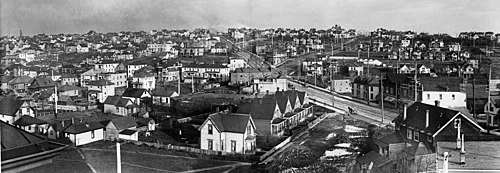Cherry Hill, Seattle
Geography
Cherry Hill is located on a north-south ridge situated east of the Seattle downtown area and First Hill, roughly equidistant between Puget Sound and Lake Washington. The neighborhood of Capitol Hill resides on the northern two-thirds of this ridge, while Cherry Hill resides on the southern third, with East Madison Street serving as the boundary between the two. The highest point of elevation in Cherry Hill is 420 feet above sea level at the broadcast towers on East Madison Street. Despite the fact that Cherry Hill and Capitol Hill designate adjacent regions of a single ridge, they are considered by Seattle historian Walt Crowley as two of the Seven Hills of Seattle.


History
The northern section of current-day Cherry Hill near Madison Street was originally named Second Hill, then later Renton Hill. The portion of the current-day Cherry Hill neighborhood bounded by Union and Cherry Streets and 10th and 20th Streets was added to the city of Seattle in 1870 as the Edes and Knight addition, and was replatted in 1890. A more southern section between Cherry and Alder Streets and 12th and 20th Avenues was added in 1890 as the Squire Park addition, after former Washington Territory governor and US Senator Watson Squire, who formerly owned the land in that section. The name Cherry Hill was suggested by city councilmember Harlan Edwards in 1959 to describe the area for an Urban Renewal Project bounded by Cherry and Yesler Streets and 17th and 23rd Avenues, which includes Squire Park. The name Cherry Hill was subsequently widely used throughout this area in the 1960s and 1970s, and was also used for structures north of Cherry Street such as the Cherry Hill Community Center and the Cherry Hill Baptist Church. The naming of a larger neighborhood named Squire Park bounded by Union and Jackson Streets and 12th and 23rd Avenues appeared with the establishment of the Squire Park Neighborhood Council in 1986. The renaming of Providence Hospital to Swedish Medical Center Cherry Hill in 2007 reintroduced the name Cherry Hill to the area from Madison Street to the hospital.
From 1959 to 1976 the Cherry Hill Urban Renewal Project mentioned above—also known as Conservation Project No. 1—was Seattle's first urban renewal project. The area between Cherry Street and Yesler Way has seen a number of progressions, with a large number of Scandinavians at the beginning of the 20th century, evolving to a predominantly Jewish neighborhood through the 1960s and a predominantly African-American neighborhood in the 1980s.
From 2016 to 2020, the Lutheran Church of the Good Shepherd and the Low Income Housing Institute sponsored a tiny house village at the corner of Union Street and 22nd Avenue. In 2020, a new tiny house village named was established on the southeast corner of Cherry Street and 22nd Avenue, on land formerly belonging to the Christ Spirit Church (formerly the Cherry Hill Baptist Church).
The enduring nature of both the Cherry Hill and Squire Park neighborhood names may be explained by advantages of each. Cherry Hill serves as a convenient replacement for the Renton Hill name, which has fallen out of favor, and acknowledges that the neighborhood shares a geographic feature with the adjacent Capitol Hill neighborhood while maintaining Madison St as the traditional southern border of Capitol Hill. Squire Park has the advantage of historical continuity and usage in property records, although this only applies for the region between Cherry and Alder Streets. Designating Cherry Hill and Squire Park as two different neighborhoods separated by Cherry Street may be a way to retain both names, although this would entail assigning the entire area originally named Cherry Hill in 1959 to Squire Park.
Landmarks (from north to south)
- Temple De Hirsch Sinai Jewish Temple
- T.T. Minor Elementary School
- Spring Street Mini Park
- Church of the Immaculate Conception, Seattle's oldest Roman Catholic Church. Built in 1904. The parish was founded by the Jesuit Fathers in 1891.
- Fire Station #23 (remodelled as the Cherry Hill Community Center in 1970)
- Cherry Hill Baptist Church Protestant Christian Church (demolished 2018)
- Swedish Hospital Cherry Hill Campus (formerly Providence Hospital): The first hospital in Seattle, established in 1877 by the Sisters of Providence, a Catholic charity. In 1910, Providence Hospital moved from its original downtown location to what was then already called Squire Park, and in 2000 became a campus of Swedish Hospital. Providence Hospital was the location of the first open-heart surgery performed in the northwest United States.
- Spruce Street Mini Park
- Washington Hall
References
- ^ "Seattle City Clerk's Office Geographic Indexing Atlas". clerk.ci.seattle.wa.us. Retrieved 2020-08-23.
- ^ "Seattle Topo Map in King".
- ^ "Seattle". www.historylink.org. Retrieved 2020-08-23.
- ^ "Seattle Historical Sites Search Result - Department of Neighborhoods (DON)". web6.seattle.gov. Retrieved 2020-08-23.
- ^ https://www.seattle.gov/Documents/Departments/Neighborhoods/HistoricPreservation/HistoricResourcesSurvey/context-central-area.pdf
- ^ https://www.seattle.gov/Documents/Departments/Neighborhoods/MajorInstitutions/SwedishCherryHill/PrelimDraftEIS-2013-11-07.pdf
- ^ https://www.seattle.gov/documents/Departments/Neighborhoods/HistoricPreservation/Landmarks/RelatedDocuments/DesRptCarmack.pdf
- ^ Unknown article, 1959-01-21, Seattle Times
- ^ https://www.seattle.gov/Documents/Departments/CityArchive/Gazette/gazette32.pdf
- ^ Chen, Su-Shuan (2017). In Pursuit of A Double-Edged Sword: The Politics of Racial Liberalism and Racial Triangulation in Seattle, 1940-1975 (Thesis). UC San Diego.
- ^ "Archives West: Central Neighborhood Service Center Records, 1977-2011". archiveswest.orbiscascade.org. Retrieved 2020-08-23.
- ^ "Providence hospital's new name inspires ire among Central Area residents". The Seattle Times. 2007-01-12. Retrieved 2020-08-23.
- ^ "Washington Hall and the beginning of Seattle's melting pot". 27 January 2020. Retrieved 2020-08-23.
- ^ "The Way We Were: Our Village in Seattle". Washington State Jewish Historical Society. Archived from the original on 2007-08-05.
- ^ Savransky, Becca; SeattlePI (2020-01-21). "Tiny house village must find new location after four years". seattlepi.com. Retrieved 2020-08-24.
- ^ "City Opens T.C. Spirit Village in Central District". homelessness.seattle.gov. Retrieved 2020-08-24.
- ^ "PCAD - City of Seattle, Fire Department (SFD), Station #23, Central District, Seattle, WA". pcad.lib.washington.edu. Retrieved 2020-08-23.
- ^ Columnist, Danny Westneat / (2018-04-20). "What if a historic church is torn down, but nobody notices?". The Seattle Times. Retrieved 2020-08-22.
- ^ http://www.seattle.gov/documents/Departments/Neighborhoods/HistoricPreservation/Landmarks/RelatedDocuments/providence-hospital-designation.pdf